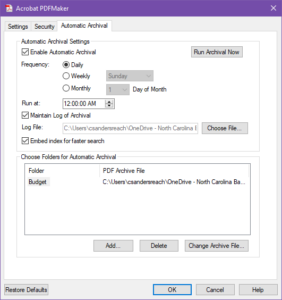Silo Busting: Sharing Client Emails within the Firm
 A lot of valuable information is passed to and received from clients via email. The problem is that the email communication a.) may need to be shared among others in the firm b.) is stored in each recipient’s mailbox. The good news is that there are a variety of ways to ensure client communications are stored with the client file and accessible to multiple people in the firm.
A lot of valuable information is passed to and received from clients via email. The problem is that the email communication a.) may need to be shared among others in the firm b.) is stored in each recipient’s mailbox. The good news is that there are a variety of ways to ensure client communications are stored with the client file and accessible to multiple people in the firm.
Use Your Practice Management or Document Management Application/Software
If you are using law practice or document management software or SaaS application, you likely can send or save email to the client/matter record. How will depend on the product. In some cases, there are plugins for MS Outlook to let you move emails with a click. In some applications you can forward the email or cc an email address that sends a copy to the client record. Some law practice management applications have email built in so that you use it instead of another application like Gmail or MS Outlook. Others let you tag emails.
If you are using a document management system, you have options or additions to send email to the DMS. Depending on the product your firm uses you may be able to add emails to the DMS by dragging them to DMS folders within Outlook, access email from within your DMS, move messages to your DMS with a right click, or other options. These options are widely available for those firms using MS Outlook, though there are options for Gmail users as well.
Use Adobe Acrobat Auto Archive
If you have the Adobe Acrobat Outlook plugin for MS Outlook, you can save emails (individual emails or entire folders) to the client file on your cloud storage or server. This can be a complex and multi-step process to get started. Each person will need to create client/matter folders in MS Outlook. Then they will need to make sure they move the client email and relevant sent mail to the client/matter folder. Users can write rules to make this easier or use a product like SimplyFile in MS Outlook. Then each user will need to set up an auto-archive via the Acrobat plugin for each folder to save the emails. The PDF archive will include all the messages and attachments in a single PDF document.
Here is a video demonstration of how email archiving works with Adobe Acrobat and MS Outlook. You can select the folder to archive by clicking on “Setup Automatic Archival” and the PDF archive of your email will update on a schedule you set so that each time an email is added to the folder the archive PDF file is updated.
If you use MS Outlook but don’t have Adobe Acrobat, you can use the Saves as PDF Pro add-in from Sperry software for $130 (one-time fee).
Of course, if people can remember to do so, they can simply right click and save the email to PDF or print to PDF and save with the client file on the server or cloud storage.
Use MS Outlook, MS Teams and Power Automate
If your firm is already using MS Teams channels you can automatically move emails to the correct channel manually by clicking the “Share to Teams” button in MS Outlook for 365, or by using Power Automate that comes with your MS 365 Business Standard or Premium subscription.
To create a Power Automate flow that moves an email to a Teams Channel is much like writing a MS Outlook rule. You will need to create the flow at the beginning of the representation and after you have created the client/matter channel. Go to Power Automate (go to Office.com and choose Power Automate from the full list of available applications or go to https://make.powerautomate.com/ and login). Then choose “Create” and choose “automated cloud flow”. Give the flow a name (Client Emails – Cindy Thomson) and the trigger “when a new email arrives Office 365 Outlook”. Then choose Advanced Options and fill in the requirements. Click “Next Step” and choose an operation. To send the email to a Teams channel chat that also saves the email as an .eml file in the Channel library choose the “Standard” tab, click on Microsoft Teams and under Actions use “Post adaptive card to channel” and choose the Team and Channel. You can use templates instead, like “Forward emails to a channel” or “Forward emails in a folder to a Channel” which will forward an email when it is place in a folder.
Create MS Outlook Group Email
In Outlook for Microsoft 365 set up a Group email (which is different from a distribution group). You will scroll down in your folders, right click on Group, create a new Group – the group email address will be the name of the group, like [email protected]. You can forward relevant emails to the group or even email directly from the group so that the client responds to the group email. Anyone added to the group can see the emails. Everyone can add the Group to their Favorites, so they don’t have to scroll down through their folders.
Use MS Outlook Rules
You can write MS Outlook rules that forward emails from certain people to a firm distribution group or specific email boxes. However, like so many of the other options above, this will require a lot of work to set up and maintain.
Conclusion
These are not all the ways you may accomplish sharing client emails with the firm. By reading the above suggestions, you may be shaking your head at how convoluted many of the steps are to complete something as simple as sharing emails to the client folder. Law practice management software and/or document management systems go a long way to improving the common business tools firms use like MS 365, Outlook and Acrobat. However, even those can become cumbersome. The products that provide client portals with communication features are the most elegant way of capturing client communication. We just need to move beyond email.
